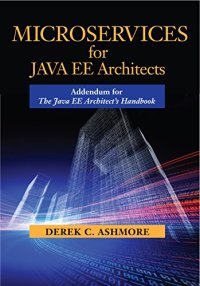
Ebook: Microservices for Java EE Architects: Addendum for The Java EE Architect’s Handbook
Author: Derek C. Ashmore
- Tags: Java, Beginner’s Guides, Reference, Servlets, Programming Languages, Computers & Technology, System Administration, Networking & Communications, Computers & Technology, Categories, Kindle Store, Java, Languages & Tools, Programming, Computers & Technology, Categories, Kindle Store
- Year: 2016
- Publisher: DVT Press
- Edition: 1
- Language: English
- epub
Given published success stories from Netflix, Amazon, and many others; many companies are adopting microservices architecture. In fact, the published success at microservices for some major companies has started a fad. For organizations that are heavily invested in Java technologies, writing microservices using Java is a natural progression.
As Java architects, we need to understand what microservices are, when to use them, and the value they provide. We need to understand design and implementation considerations for using microservices so that we can guide a development team through microservice development efforts. We also need to understand the various pitfalls of using microservices and common implementation mistakes that can erode the benefits of using microservices.
While this book is a companion to the Java EE Architect's Handbook, it is separate and self-contained. Like the handbook, I'll guide architects through the entire development process. I provide guidance on how to effectively design service contracts. I cover coding patterns in detail that are needed to make microservice libraries effective with code examples along the way. I provide guidance on how to refactor large, complex web applications into smaller and more manageable microservices. I provide guidance on making microservices easier to maintain and support.
What you’ll learn
- What microservices architecture is and the advantages and disadvantages to using it.
- How to refactor large applications into a microservice library.
- How to design microservice contacts effectively.
- Design patterns that make microservices efficient and maintainable.
- Guidance in how to manage microservice development teams.
- Best practices and common mistakes for implementing microservices.
Who this book is for
- Java EE application and enterprise architects interested in using microservices to provide business value.
- Java EE technical leads implementing microservices.
- Java EE senior Java developers working on microservice teams.